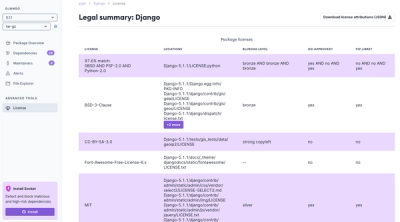
Product
Introducing Ruby Support in Socket
Socket is launching Ruby support for all users. Enhance your Rails projects with AI-powered security scans for vulnerabilities and supply chain threats. Now in Beta!
@aws-cdk/aws-cloudformation
Advanced tools
This module is part of the AWS Cloud Development Kit project.
Custom Resources are CloudFormation resources that are implemented by arbitrary user code. They can do arbitrary lookups or modifications during a CloudFormation synthesis run.
You will typically use Lambda to implement a Construct implemented as a
Custom Resource (though SNS topics can be used as well). Your Lambda function
will be sent a CREATE, UPDATE or DELETE message, depending on the
CloudFormation life cycle. It will perform whatever actions it needs to, and
then return any number of output values which will be available as attributes
of your Construct. In turn, those can be used as input to other Constructs in
your model.
In general, consumers of your Construct will not need to care whether it is implemented in term of other CloudFormation resources or as a custom resource.
Note: when implementing your Custom Resource using a Lambda, use
a SingletonLambda so that even if your custom resource is instantiated
multiple times, the Lambda will only get uploaded once.
The following shows an example of a declaring Custom Resource that copies files into an S3 bucket during deployment (the implementation of the actual Lambda handler is elided for brevity).
The aws-cdk-examples repository has examples for adding custom resources.
See the following section of the docs on details to write Custom Resources:
Nested stacks are stacks created as part of other stacks. You create a nested stack within another stack by using the NestedStack construct.
As your infrastructure grows, common patterns can emerge in which you declare the same components in multiple templates. You can separate out these common components and create dedicated templates for them. Then use the resource in your template to reference other templates, creating nested stacks.
For example, assume that you have a load balancer configuration that you use for most of your stacks. Instead of copying and pasting the same configurations into your templates, you can create a dedicated template for the load balancer. Then, you just use the resource to reference that template from within other templates.
The following example will define a single top-level stack that contains two nested stacks: each one with a single Amazon S3 bucket:
import { Stack, Construct, StackProps } from '@aws-cdk/core';
import cfn = require('@aws-cdk/aws-cloudformation');
import s3 = require('@aws-cdk/aws-s3');
class MyNestedStack extends cfn.NestedStack {
constructor(scope: Construct, id: string, props?: cfn.NestedStackProps) {
super(scope, id, props);
new s3.Bucket(this, 'NestedBucket');
}
}
class MyParentStack extends Stack {
constructor(scope: Construct, id: string, props?: StackProps) {
super(scope, id, props);
new MyNestedStack(this, 'Nested1');
new MyNestedStack(this, 'Nested2');
}
}
Resources references across nested/parent boundaries (even with multiple levels of nesting) will be wired by the AWS CDK
through CloudFormation parameters and outputs. When a resource from a parent stack is referenced by a nested stack,
a CloudFormation parameter will automatically be added to the nested stack and assigned from the parent; when a resource
from a nested stack is referenced by a parent stack, a CloudFormation output will be automatically be added to the
nested stack and referenced using Fn::GetAtt "Outputs.Xxx" from the parent.
Nested stacks also support the use of Docker image and file assets.
1.31.0 (2020-03-24)
acm: Allow tokens as a part of the hosted zone name (#6685) (acfb6ef), closes #6133
aws-ecs-patterns: only create an A record if LB is public (#6895) (f31f4e1), closes #6702
cdk-assets: context path not honored by Docker asset build (#6957) (1edd507), closes #6954 #6814
cloudwatch: unhelpful error when reusing metric IDs (#6892) (60253a3)
cognito: user pool - link style email verification fails to deploy (#6938) (b5c60d5), closes #6811
ec2: spelling error in Instance's subnet selection logic. (#6752) (564561a)
iam: immutable role cannot be used as a construct (#6920) (56be032), closes #6885
FAQs
The CDK Construct Library for AWS::CloudFormation
The npm package @aws-cdk/aws-cloudformation receives a total of 63,493 weekly downloads. As such, @aws-cdk/aws-cloudformation popularity was classified as popular.
We found that @aws-cdk/aws-cloudformation demonstrated a not healthy version release cadence and project activity because the last version was released a year ago. It has 4 open source maintainers collaborating on the project.
Did you know?

Socket for GitHub automatically highlights issues in each pull request and monitors the health of all your open source dependencies. Discover the contents of your packages and block harmful activity before you install or update your dependencies.

Product
Socket is launching Ruby support for all users. Enhance your Rails projects with AI-powered security scans for vulnerabilities and supply chain threats. Now in Beta!

Product
Ensure open-source compliance with Socket’s License Enforcement Beta. Set up your License Policy and secure your software!

Product
We're launching a new set of license analysis and compliance features for analyzing, managing, and complying with licenses across a range of supported languages and ecosystems.